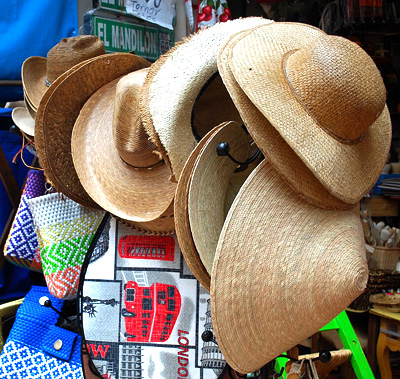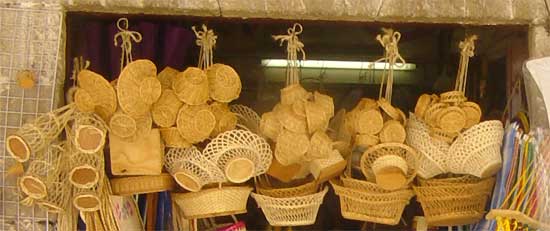Here are some Mexican-Spanish words often heard in the mercado's basket-weaving circles:

Inside a henequen mill someplace in the Yucatan, some years back, the details forgotten; image courtesy of Ruth McMurtry of Mérida, Yucatan..
- chuspata: a kind of marsh plant used for weaving
- colote: large, conical basket made with reed
- guano: fiber of palm of the genus Sabal
- henequén: henequen, fiber shown at the right, produced by an agave grown extensively in the Yucatán
- huano = guano
- ixtle: fiber of maguey agave or, sometimes, other plants
- lechuguilla: fiber from the lechuguilla plant, an agave
- popote: "straw" -- slender grass stem used in basketry
- sotol: a kind of agave producing strong fibers used in weaving
- tule: a kind of marsh plant, particularly cattail and papyrus-like plants
- zapupe: fiber obtained from a species of agave
In our "Profile" section, Francisca García Peralta, from San Luis Amatlán, Oaxaca, does a beautiful job describing the weaving of baskets, and explaining how each design has a name. In case you'd like to visit a town specializing in woven baskets, here are some of the best known:
- Tequisquiapan, Querétaro, producing particularly beautiful designs.
- Tasquillo, Hidalgo, whose peculiar baskets are woven of reed and equipped with tops.
- Toluca, Mexico State, which produces polychrome baskets of palm, decorated with human and animal forms, and traditional symmetrical patterns.
- Chilapa, Guerrero, whose de tripilla bags made of palm frond are mostly sold in Acapulco and Taxco

Woven hats on sale at the
Mercado Artesanal of Tequisquiapan, Querétaro;
copyright-free image courtesy of "Thelmadatter" made available through Wikimedia Commons..
The process of weaving hats using plant fibers is basically the same as weaving baskets -- just with the end result fits over the head and has a brim. One of the two main hat-weaving regions of Mexico is the Mixteca Alta region, the highland area occupied by Mixtec people, covering parts of Puebla, Oaxaca, and Guerrero.
In certain lakeside and riverside communities, such as Tzintzuntzan on Lake Pátzcuaro and towns along the Río Lerma in Mexico State, mats are woven of dried, ironed blades of tule, a name applied indiscriminately to cattail and similar marsh plants such as papyrus-like species of the genus Cyperus.




